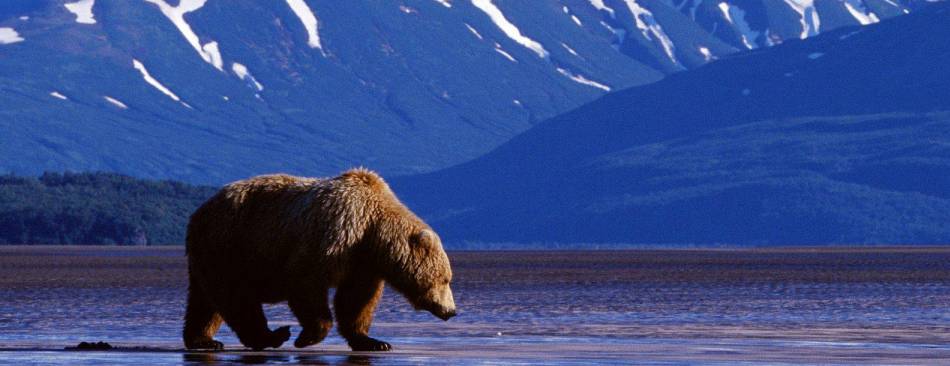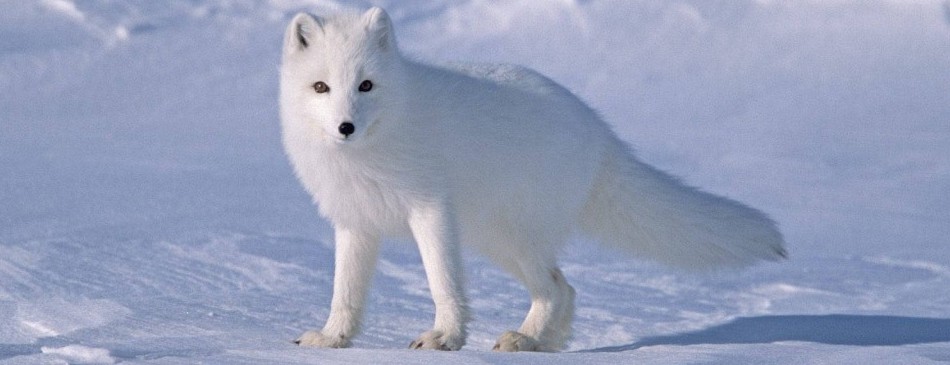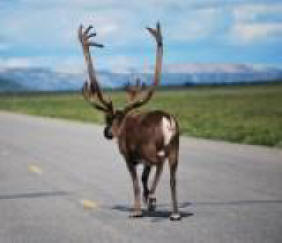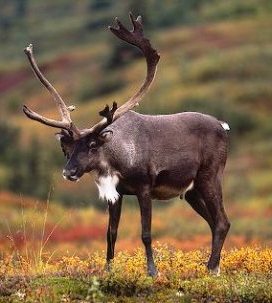Caribou live in the arctic tundra, mountain tundra and northern forests of Alaska. There are 32 herds and approximately 900,000 wild caribou in Alaska (compare that to only about 700,000people)! Caribou calving areas, where baby caribou are born, are usually located in the mountains or on open coastal tundra. In the early summer, after calves are born, caribou gather together in large aggregations.
In Alaska, caribou prefer treeless tundra and mountains during all seasons, but many herds winter in the boreal forest (taiga). Calving areas are usually located in mountains or on open, coastal tundra. Caribou tend to calve in the same general areas year after year, but migration routes used for many years may suddenly be abandoned in favor of movements to new areas with more food. Changing movements can create problems for the Native people in Alaska and Canada who depend upon caribou for food.
Caribou movements are probably triggered by changing weather conditions, such as the onset of cold weather or snowstorms. Once they decide to migrate, caribou can travel up to 50 miles a day. Caribou apparently have a built in compass, like migratory birds, and can travel through areas that are unfamiliar to them to reach their calving grounds. Caribou have large, concave hoofs that spread widely to support the animal in snow and soft tundra. The feet also function as paddles when caribou swim. Caribou are the only member of the deer family in which both sexes grow antlers. Antlers of adult bulls are large and massive; those of adult cows are much shorter and are usually more slender and irregular. In late fall, caribou are clove-brown with a white neck, rump, and feet and often have a white flank stripe. The hair of newborn calves is generally reddish-brown. Newborn calves weigh an average of 13 pounds (6 kg) and grow very quickly. They may double their weight in 10-15 days. Weights of adult bulls average 350-400 pounds (159-182 kg). However, weights of 700 pounds (318 kg) have been recorded. Mature females average 175-225 pounds (80-120 kg). Caribou in northern and southwestern Alaska are generally smaller than caribou in the Interior and in southern parts of the state.
In Europe, caribou are called reindeer, but in Alaska and Canada only the domestic forms are called reindeer. All caribou and reindeer throughout the world are considered to be the same species, but there are 7 subspecies.
The shedding of velvet (the fur covering on antlers) in late August and early September by large bulls marks the approach of the rutting (breeding) season and the start of fall migration. Mature bulls frequently have more than three inches of fat on the back and rump, which is used to provide energy needed during the rut. The necks of adult bull caribou swell enormously in September due to the natural production of steroid hormones like testosterone. Fighting begins in early September and becomes more frequent as the rut approaches at the end of the month. Most fights between bulls are brief bouts, but violent fights occur, and many bulls are seriously injured or killed during the rut. Many injured or exhausted bulls are killed by wolves and bears after the rut. Unlike many other members of the deer family, bull caribou do not control a harem of cows. Instead, they control a space around themselves, and prevent other bulls from breeding females within their space. The largest bulls shed their antlers in late October, but small bulls and non-pregnant cows do not shed their antlers until April. Pregnant females usually retain their antlers until calves are born in late May or early June.
Caribou are somewhat cyclic in number, but the timing of declines and increases, and the size to which herds grow is not very predictable. Although overhunting caused some herds to remain low in the past, today, varying weather patterns (climate), population density, predation by wolves and grizzly bears, and disease outbreaks determine whether most herds increase or decrease. In the 1970s people were concerned about the effect of the trans-Alaska oil pipeline, expanding oil development, and increased disturbance from use of aircraft and snowmobiles on caribou. Although there was some displacement of caribou calving in the Prudhoe Bay oilfield, in general, caribou have not been adversely affected by human activities in Alaska. Pipelines and most other developments are built to allow for caribou movements, and caribou have shown us that they can adapt to the presence of people and machines. As human activities expand in Alaska, the great challenge for caribou management is for man to consider the needs of our caribou herds and ensure that they remain a visible, healthy part of our landscape.
|








